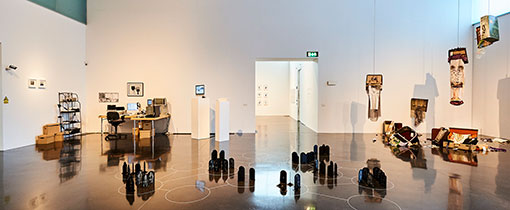
The Creative Industries in Wolverhampton
The School of Creative Industries has a heritage that stretches back to the period of the Great Exhibition of 1851; our vision is to shape the future of the arts and creative industries in contemporary society.
Since our earliest days we’ve been well connected in the arts. From the pioneering vision of George Wallis in the 1830s, the works of world-leading architect Charles Wheeler in the 1960s, to our current associations with Turner Prize nominees Jane and Louise Wilson and the fashion illustrator David Downton, Wolverhampton can rightly claim true international reach.
The iconic George Wallis building on Molineux Street is the home of our expert practitioners, exploring the beauty of form and materials and solving practical challenges in subjects rooted in a contemporary curriculum. Recognised for the quality of their research, both in the UK’s Research Excellence Framework and internationally, staff continually feed the latest research innovations into their teaching, providing both inspiration and practical support to students.
Students at the School of Creative Industries can investigate a wide range of specialisms in an environment where they benefit from close contact with others researching, teaching and working in sympathetic media. Whether their chosen medium is physical or digital, students are given the freedom to explore and express their craft.
Learning, collaborating and inspiring together in a creative community, students further benefit from the School’s well-established industry links, with live briefs, exhibitions and placement opportunities an integral part of the student journey to becoming independent, talented, successful graduates.
The School of Art at the University of Wolverhampton: a crucible for world renowned art.
Past, present and future
The School of Creative Industries was created in 1851 in Castle Street. At this time, an evolving arts school movement stoked the emerging tastes and aspirations of a public hungry for beautiful home-grown products.
The year’s Great Exhibition highlighted an urgent need for innovation in art and design to serve the needs of industry. In Wolverhampton, it was recognised that improvements were essential to international success. This led to local exhibitions of arts and crafts at the Wolverhampton Mechanics Institutes, which together with the School of Art became the foundation of the University of Wolverhampton.
George Wallis – a deputy commissioner for the Exhibition charged with co-ordinating a display from his region – was a pioneer, encouraging engagement with the arts and championing beautiful design that simultaneously serves a practical purpose.
With the public fired with enthusiasm by the year’s Great Exhibition, the School was immediately over-subscribed. With interest high and Wallis’ support, by 1854 a larger School of Practical Art opened in Darlington Street.
From humble beginnings the School has grown to be recognised as an innovative provider of art education with distinguished alumni working worldwide, challenging convention and creating pieces worthy of admiration, celebration and respect.
Find Us
Follow Us
Instagram: @wlvcreativeindustries
Twitter: @ wlvsoci
Join our Mailing List
Sign up and receive regular updates via our monthly newsletter!
Visit
School of Art: www.wlv.ac.uk/soa
Screen School: www.wlv.ac.uk/screenschool
Make a Course Enquiry
If you are interested in any of our courses - contact us using the button below.


/prod01/wlvacuk/media/departments/digital-content-and-communications/images-18-19/iStock-163641275.jpg)
/prod01/wlvacuk/media/departments/digital-content-and-communications/images-2024/250630-SciFest-1-group-photo-resized-800x450.png)
/prod01/wlvacuk/media/departments/digital-content-and-communications/images-18-19/210818-Iza-and-Mattia-Resized.jpg)
/prod01/wlvacuk/media/departments/digital-content-and-communications/images/Maria-Serria-(teaser-image).jpg)
/prod01/wlvacuk/media/departments/digital-content-and-communications/images-2024/241014-Cyber4ME-Project-Resized.jpg)
/prod01/wlvacuk/media/departments/digital-content-and-communications/images-18-19/210705-bric_LAND_ATTIC_v2_resized.jpg)
/prod01/wlvacuk/media/departments/faculty-of-arts/images/degree-show/degree-show-2019/banners/SOA-Buidling-video-Banner.jpg)







